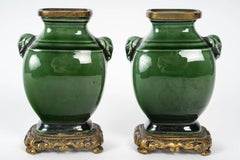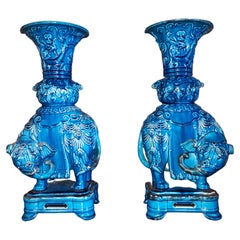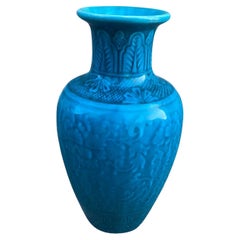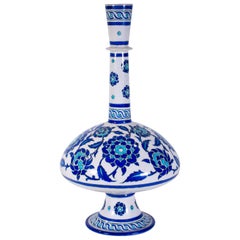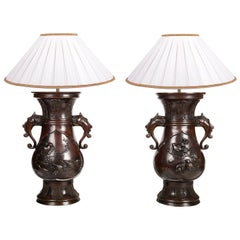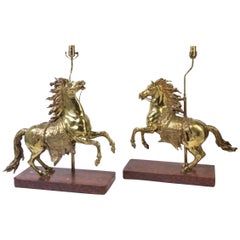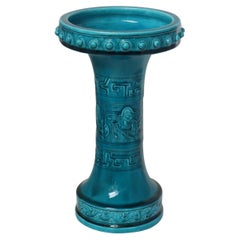Theodore Deck Vases and Vessels
1
8
to
5
3
8
8
8
1
8
Height
to
Width
to
8
4
4
3
2
8
8
8
1,074
550
395
383
Creator: Theodore Deck
Théodore Deck (1823-1891), Miniature Pair of Faience Vases circa 1870
By Theodore Deck
Located in Saint-Ouen, FR
Theodore Deck (1823-1891)
A deep green enameled faience miniature pair of vases molded in the Chinese Archaistic Taste.
Coves in the shape of elepha...
Category
1870s French Chinoiserie Antique Theodore Deck Vases and Vessels
Materials
Faience
Pair of Theodore Deck Vases
By Theodore Deck
Located in Saverne, Grand Est
Extremely rare pair of Gu-shaped turquoise enamelled ceramic vases, carried by elephants and resting on an openwork base ending in four flared feet. Some lack of enamel otherwise ver...
Category
1880s French Japonisme Antique Theodore Deck Vases and Vessels
Materials
Ceramic
Théodore Deck, Ceramic Vase, Signed, circa 1870
By Theodore Deck
Located in Saint-Ouen, FR
Théodore Deck (1823-1891), ceramic vase, signed, circa 1870.
Category
Late 19th Century French Art Nouveau Antique Theodore Deck Vases and Vessels
Materials
Ceramic
Large Theodore Deck Earthenware Bottle Form Vase in the Islamic/Iznik Taste
By Theodore Deck
Located in New York, NY
A large and impressive Theodore Deck Earthenware bottle form vase in the Islamic/Iznik Taste, Impressed "TD" 1870 on the bottom. The narrow circular neck is decorated with dark blue,...
Category
1870s French Islamic Antique Theodore Deck Vases and Vessels
Materials
Porcelain
Theodore Deck '1823-1891', a Japonisme Polychromed Faience Quadrangular Vase
By Theodore Deck
Located in Saint-Ouen, FR
Theodore Deck (1823-1891)
A Polychromed Faience quadrangular vase, decorated in a cartouche with butterfly and birds on branches of prunus and peonies in the Japanese Taste on a pu...
Category
Late 19th Century French Japonisme Antique Theodore Deck Vases and Vessels
Materials
Faience
Pair of Gilt Bronze Mounted Faience Lamps by Deck
By Theodore Deck, Gagneau Frères
Located in London, GB
These beautiful table lamps are by Théodore deck, one of the most important ceramicists of the 19th Century, and Gagneau Frères, a leading bronzier. Deck was the director of a presti...
Category
Late 19th Century French Antique Theodore Deck Vases and Vessels
Materials
Ormolu, Bronze
French Chinoiserie Style Earthenware Turquoise Blue Ground Planter or Jardinière
By Theodore Deck
Located in New York, NY
A marvelous French chinoiserie style earthenware dore bronze mounted turquoise blue ground planter or jardinière, attributed to Théodore Deck. The ceramic bowl is beautifully decorat...
Category
1880s French Chinoiserie Antique Theodore Deck Vases and Vessels
Materials
Bronze
Pair of Ormolu-Mounted Theodore Deck Faience Persian-Blue Vases with Lampshades
By Theodore Deck
Located in Palm Desert, CA
A pair of late 19th century ormolu-mounted faience Persian-blue vases by Theodore Deck, mounted as oil lamps. As in traditional Persian design, the lamps are bottle-shaped, with a wi...
Category
19th Century French Antique Theodore Deck Vases and Vessels
Materials
Ormolu
Related Items
Pair of Meiji Period Japanese Bronze Vases / Lamps
Located in Brighton, Sussex
An impressive pair of late 19th century (Meiji period 1868-1912) Japanese bronze vases / lamps. Each with
re-leaf decoration of birds and trees, mythical creatures as handles either...
Category
Late 19th Century Japanese Antique Theodore Deck Vases and Vessels
Materials
Bronze
Pair of Gilt Bronze Horses Mounted as Lamps
Located in Buchanan, MI
A pair of gilt bronze horses
each in the form of a galloping horse, raised on a faux marble rectangular plinth with rounded corners and mounted as l...
Category
20th Century Theodore Deck Vases and Vessels
Materials
Bronze
Pair of Large Stunning Burmantofts Faience Floral Vases
By Burmantofts Pottery
Located in Bishop's Stortford, Hertfordshire
A stunning pair of Burmantofts Faience vases of slender baluster form, cast in low relief with flowers and foliage, in shades of blue, turquoise, green, yellow and red on a cream gro...
Category
1880s English Antique Theodore Deck Vases and Vessels
Materials
Pottery
Antique Pair of Chinese Yellow Ground Porcelain Miniature Vases
Located in New York, NY
Lovely pair of miniature Chinese yellow ground porcelain vases with applied plum blossom trees and butterflies. Each Stand on circular rosewood b...
Category
Early 20th Century Chinese Chinoiserie Theodore Deck Vases and Vessels
Materials
Porcelain
Pair of Romantic Yellow Tole Urns Mounted as Lamps
Located in Kittery Point, ME
Each mounted as a lamp, the flaring top above a stepped square base, with a decor of antique scenes and symbols. Electrified. Measures: Height of urns only, 15in.; height overall, 29...
Category
19th Century French Romantic Antique Theodore Deck Vases and Vessels
Materials
Tôle
Petite French Faience Vase Desvres, circa 1900
By Desvres
Located in Austin, TX
Small French faience jardinière with floral pattern Desvres, circa 1900.
Category
Early 1900s French French Provincial Antique Theodore Deck Vases and Vessels
Materials
Ceramic, Faience
Pair of French Faience Vases by Jules Vieillard
Located in Winter Park, FL
Pair of 19th century French faience vases by Jules Vieillard of Bordeaux. Italian Renaissance style decoration depicting Venus. Mint condition. Mark to underside: JVB. Please refer t...
Category
19th Century French Renaissance Antique Theodore Deck Vases and Vessels
Materials
Faience
Pair 19th Century Antique Islamic Ottoman Iznik Kutahya Bottle Vases Turkey 1820
Located in Portland, OR
A good pair of antique early 19th century Ottoman Islamic Iznik/Kutahya pottery bottle vases, Turkey, circa 1820.
The vases of bottle form with a flare...
Category
Early 19th Century Turkish Islamic Antique Theodore Deck Vases and Vessels
Materials
Pottery
French Faience Vase HB Quimper, Circa 1920
By Quimper Faience Pottery
Located in Austin, TX
French Faience vase signed HB Quimper Circa 1920.
Category
1920s French Rustic Vintage Theodore Deck Vases and Vessels
Materials
Faience
19th Century Delft Polychrome Faience Vase
Located in Winter Park, FL
A 19th century delft faience polychrome painted vase with round body and narrow neck ending in an open bulb. Beautifully decorated in blue, orange, brown and green with large medalli...
Category
19th Century Dutch Chinoiserie Antique Theodore Deck Vases and Vessels
Materials
Faience
French 19th Century Pair of Lacquered Bamboos Japonisme Vases
By Edouard Lievre, Ferdinand Barbedienne
Located in Saint-Ouen, FR
A 19th French century pair of Lacquered Bamboos Japonisme vases.
An amazing pair of tall cylindrical bamboo vases decorated in Japanese Gold and Sil-ver Hiramaki-E Lacquer with Pavilions in The Mist and Weaving Figures, Flown Over by a Pair of Cranes. Enclosed in a Sino-Japanese Inspiration Golden and Brown Patina Bronze Mount Featuring Elephant Heads, Partially Openwork Branches and Salamanders Forming Side Handles.
Circa 1870
Attributed to Édouard Lièvre (1828-1886) and Ferdinand Barbedienne (1810-1892)
Édouard Lièvre (1828-1886) is one of the most talented and prolific designer and industrialist of the 19th Century, his repertoire is sometimes Sino-Japanese or Neo-Renaissance, whether in furniture or works of art, we can note in particular the parade bed of Valtesse de La Bigne, furniture commissioned by the painter Édouard Detaille or even Sarah Bernhardt, and the famous works in collaboration with Maison Christofle or those in gilded bronze and cloisonné enamel edited by Ferdinand Barbedienne, presented at the Universal Exhibitions in 1878, 1889 and 1900.
He was both a draftsman, painter, illustrator, engraver, ornamentalist and cabinetmaker, first trained in the studio of the painter Thomas Couture, Lièvre was then fully immersed in the world of decoration, creation and ornamentation and provides designs for manufacturers and merchant-publishers.
Often assisted by his brother Justin, he first produced works of art for his own apartment, seeking out the finest craftsmen to execute his designs for bronzes, ceramics, fabrics and luxury furniture from great virtuosity and great taste. He then collaborated with the cabinet-maker Paul Sormani, as well as haberdasher merchants such as the Escalier de Cristal, bronziers such as Maison Marnyhac and especially Ferdinand Barbedienne as on our vases with bronze mounts characteristics of Edouard Lièvre's work.
Born in 1810, died in Paris in 1892, Ferdinand Barbedienne, the most important caster of bronze pieces of art during the second half of the 19th Century, created and directed in Par-is one of the major artistic foundries of his time. Barbedienne specialized in classical reproductions, whose models were exposed in famous European museums. Their illustrated catalogues included many diverse objects such as busts, ornemental sculpture (clocks, candelabras, cups) sometimes even life-sized and bronzes for furniture. Apart from his own produc-tion, Barbedienne worked for the most renowned sculptors such as Barrias, Clésinger and Carrier-Belleuse. All his works were highly esteemed and he, himself honored by contemporary critics. At the London exhibition in 1851 Barbedienne’s firm won two « Council medals ». At the 1855 Universal Exhibition, he won a medal of honor. The success of Barbedienne’s firm brought him many official commissions, such in about 1860, as Barbedienne supplied bronzes for furniture for the Pompeian Villa of Prince Napoléon-Joseph, located avenue Montaigne in Paris. At the London Universal Exhibition of 1862 Barbedienne won medals in three different categories: Furniture, Silversmith work and Artistic bronzes. Barbedienne was made an officer of the Légion d’Honneur in 1867 and Commander in 1878 when he was compared with « a prince of industry and the king of bronze casting ». His glory did not decline with the passage of the time for at the Universal Exhibition of 1889 the critics thanked Barbedienne for the example he set for other bronze-casters by the perfection of his bronzes.
“Japonisme” in the second half of the 19th century, was a craze for everything that came from Japan or imitated its style. The word was first coined in a series of articles published by Philippe Burty, from May 1872 to February 1873, in the French magazine “la Renaissance Littéraire et Artistique”. Far from the Academic sphere, artists seeking for new ways of expression, appropriated this discovery. Manet and the impressionists led the way to half a century of enthusiasm for Japanese art, and largely contributed to the esthetical revolution Europe experienced between 1860 and the beginning of the twentieth century.
From 1862, The World’s Fairs provoked massive arrivals of fans, kimonos, lacquers, bronzes, silks, prints and books that launched the real era of Japonisme. With those exhibitions, the demand was boosted, the number of merchants and collectors was multiplied, and artists became passionate about this new esthetic. For them, its “primitivism” was probably its most important quality: artists were fond of the Japanese art’s capacity to be close to nature and to reconcile art and society by representing, with a lot of care, the most trivial objects.
In painting, Edouard Manet, Mary Cassatt, Degas, Van Gogh, Gauguin were among those who were deeply inspired by Japanese art, affected by the lack of perspective and shadow, the flat areas of strong color, the compositional freedom in placing the subject off-center, with mostly low diagonal axes to the background. The Japanese iris, peonies, bamboos, kimonos, calligraphy, fish, butterflies and other insects, the blackbirds, cranes and wading birds, the cats, tigers, and dragons were endless sources of inspiration, appropriation, and reinterpretation for European artists. The occidental productions were combining styles and artistic conceptions instead of copying Japanese art slavishly. That is what brings to light the comparison between the artworks of Kitagawa Utamaro and Degas, of Katsushika Hokusai and Van Gogh
The World’s Fairs of 1851 and 1862 in London, those of 1867, 1878, 1889 and 1900 in Paris, of 1873 in Vienna and of 1904 in Saint Louis presented a number of “Japanese-Chinese” installations with earthenware, bronzes, screens and paintings and attracted the largest amounts of visitors In Vienna, the “Japanese village...
Category
1870s French Japonisme Antique Theodore Deck Vases and Vessels
Materials
Bronze
Ceramic Vase by Daniel De Montmollin, circa 1980-1990
By Daniel de Montmollin
Located in Neuilly-en- sancerre, FR
A ceramic vase with glaze decoration by Daniel de Montmollin.
Perfect original conditions.
Signed at the base.
Circa 1980-1990.
Unique piece.
Category
20th Century French Beaux Arts Theodore Deck Vases and Vessels
Materials
Ceramic
Previously Available Items
Pair of French Theodore Deck Ormolu-Mounted Celadon Porcelain Lamps
By Theodore Deck
Located in New York, NY
A Pair of French Theodore Deck ( 1823-1891) Ormolu-Mounted Celadon Porcelain Lamps, circa 1870.
A very elegant pair of celadon green porcelain lamps in the Chinese taste, mounted ...
Category
19th Century French Antique Theodore Deck Vases and Vessels
Materials
Ormolu
Theodore Deck (1823-1891) , A Chinese Archaïc Taste Blue Faience Vase circa 1875
By Theodore Deck
Located in Saint-Ouen, FR
A Theodore Deck (1823-1891) Faience Persian blue, " Bleu Deck" Diabolo shape Vase
Moulded in low relief and incised with fretwork and scrolls pattern in the Chinese Archaistic taste,
Impressed Uppercase TH.DECK mark.
circa 1875
Illustrated in "Théodore Deck ou l'éclat des émaux 1823-1891", Exhibition Catalogue held in Musée de Marseille, under # 24 page 54
Born in Guebwiller in Alsace, Théodore Deck trained as a ceramist in his home region, then in Germany. He went into partnership with his brother, Xavier Deck, to create his own factory in Paris in 1858. At the Exhibition of Industrial Arts in 1864, he presented pieces covered with transparent enamels that were not cracked, and then made his first attempts at reliefs under transparent enamels. He developed a bright turquoise color, famously renowned as "Bleu Deck". It is this nuance that we find on the salamander represented on this vase. In 1887 he published a treatise entitled "La Faïence", in which he explained some of his discoveries. That same year, he became director of the Manufacture de Sèvres.
Theodore Deck (1823-1891) is a French ceramist born in Guebwiller in Alsace. He is passionate about chemistry and the physical sciences. In 1841, he joined the master stove maker Hügelin father as an apprentice in Strasbourg. In two years, he learned of the methods inherited from the 16th century, such as the encrustation of colored pastes in the style of Saint-Porchaire. This apprenticeship did not prevent him from spending his free time draw-ing or modeling clay in the studio of sculptor André Friederich. Escaping military service, he made a tour of Germany as is the tradition with fellow Alsatian stove-makers. The quality of his work allows him to obtain important orders in Austria for the castles of the provinces and the imperial palaces, in particular for the palace of Schönbrunn. He continues his journey in Hungary to Pest, to Prague, then, going north through Dresden, Leipzig, Berlin and Hamburg. On the strength of his apprenticeship, he arrived in Paris in 1847. Recommended by Hügelin, he went to the stove factory of the Bavarian potter Vogt, located rue de la Roquette. The Revolution of 1848 interrupts production and Deck decides to return to his hometown. His family then advised him to set up a small terracotta workshop: he made a few busts, statuettes, vases, lamps and copies of famous antiques there. Aware that this situ-ation would not allow him to provide for himself properly, he returned to Paris in 1851 where he was employed by the widow Dumas, daughter of the earthenware maker Vogt for whom he had worked. Hired as a foreman, he supplied the drawings and models to the workers, while working the land himself.
The following year, he made the decision to settle not far from his former employer at 20, rue de la Fontaine-au-Roi, probably using his ovens. His brother, Xavier Deck, joins him. It was officially in 1858 that the Deck brothers created their business and settled in Paris at 46, boulevard Saint-Jacques. Initially, the brothers only carry out coatings for stoves. But the business is going so well that barely a year after their installation, they want to diversify their production and engage in ceramics for the cladding of buildings as well as in shaped parts. Deck is interested in politics. In 1870, he opted for French nationality and was elect-ed deputy mayor in the 15th arrondissement of Paris.
In 1861, at the Salon des arts et industries de Paris, which was held on the Champs-Élysées, Théodore Deck exhibited his works for the first time: these were pieces with an inlay decoration called “Henri II” and others. pieces covered with turquoise blue enamel or decoration in the style of Iznik ceramics.If he wins a silver medal, reviews are mixed, however. The following year, on the occasion of the Universal Exhibition of 1862 in London, he won over English customers. He surprised by presenting, like the previous year, his Alhambra Vase of exceptional dimensions (1.36 m in height and 2.25 m in circumference) which was purchased by the South Kensington Museum a few years later. At this same exposure, however, we notice the numerous cracks in its glaze and its poor adhesion to the dough. At the Indus-trial Arts Exhibition of 1864, Deck managed to present pieces coated with transparent, non-cracked enamels, and then made his first attempts at reliefs under transparent enamels. He developed a bright turquoise colour, which he named "Bleu Deck".
Théodore Deck explained the manufacture and qualities of these transparent enamels when he published his treatise La faïence in 1887. A year later, he made the first tests of reliefs in transparent enamels. He will never abandon this technique which will also be taken up by several large manufacturers. Inspired to pastiche by Islamic...
Category
1870s French Chinese Export Antique Theodore Deck Vases and Vessels
Materials
Faience
H 10.24 in Dm 5.91 in
Theodore Deck Islamic/Alhambra Style Green-Glazed Earthenware Vase on Pedestal
By Theodore Deck
Located in New York, NY
A Monumental Exceptionally Made Islamic style green glazed earthenware three-piece vase and pedestal centerpiece. This is an extraordinary earthenwar...
Category
1890s French Islamic Antique Theodore Deck Vases and Vessels
Materials
Earthenware
Théodore Deck, Ceramic Vase, Signed, circa 1870
By Theodore Deck
Located in Saint-Ouen, FR
Théodore Deck (1823-1891), ceramic vase, signed, circa 1870.
Category
Late 19th Century French Art Nouveau Antique Theodore Deck Vases and Vessels
Materials
Ceramic
Impressive Théodore Deck Oriental Design Enameled Faience Vase, circa 1875
By Theodore Deck
Located in Saint-Ouen, FR
Théodore Deck (1823-1891)
An Impressive baluster shape vase on a celadon background with light relief and brown decoration of scrolls, rosettes, shells and arabesques in the orienta...
Category
1870s French Archaistic Antique Theodore Deck Vases and Vessels
Materials
Faience
H 22.45 in W 9.85 in D 9.85 in
Théodore Deck Faience Iznik Baluster Vase
By Theodore Deck
Located in Saint-Ouen, FR
A Théodore Deck (1823-1891) Iznik Baluster polychromed vase
Persian Islamic design
Impressed Uppercase TH.DECK Mark under the base
Dated 1870.
Category
1870s French Islamic Antique Theodore Deck Vases and Vessels
Materials
Faience
Théodore Deck Faience Blue Persian Baluster Vase
By Theodore Deck
Located in Saint-Ouen, FR
A Théodore deck faience blue Persian vase
Impressed TH.DECK Mark.
Category
1870s French Japonisme Antique Theodore Deck Vases and Vessels
Materials
Faience
Theodore Deck Deep Green Enamel Faience Pair of Vases
By Theodore Deck
Located in Saint-Ouen, FR
A Theodore Deck (1823-1891) deep green enamelled faience pair of vases moulded in the Chinese archaistic taste
Coves in the shape of elephant heads.
With originals Théodore deck's ...
Category
1870s French Chinoiserie Antique Theodore Deck Vases and Vessels
Materials
Faience
Théodore Deck Japonisme Aesthetic Blue-Ground Faience Jardinière, circa 1880
By Theodore Deck
Located in Saint-Ouen, FR
A polychrome Theodore deck blue-ground enameled faience jardinière
of waisted flaring form, painted in the Japonisme Aesthetic with Dogrose, wisteria and other flowering branches a...
Category
1880s French Japonisme Antique Theodore Deck Vases and Vessels
Materials
Bronze
Théodore Deck Blue-Persian Faience Islamic Design Jardinière 19th Century
By Theodore Deck
Located in Saint-Ouen, FR
A Rectangular Théodore Deck blue-Persian faience cachepot in the Islamic style, modelled in low relief and incised with interlacing and rosette pattern.
With original zinc planter r...
Category
Late 19th Century French Islamic Antique Theodore Deck Vases and Vessels
Materials
Faience
H 5.52 in W 16.54 in D 8.67 in
Theodore Deck, Japonisme Polychromed Faience Baluster Vase
By Theodore Deck
Located in Saint-Ouen, FR
A Theodore Deck (1823-1891) polychromed Faience Baluster vase, the body richly decorated with vegetation’s, birds, butterflies and stork in the Japanese Taste in Cloisonné Imitation
...
Category
Late 19th Century French Japonisme Antique Theodore Deck Vases and Vessels
Materials
Faience
Théodore Deck Japonisme Aesthetic Blue-Ground Faience Jardinière, circa 1880
By Theodore Deck
Located in Saint-Ouen, FR
A Polychrome Theodore deck blue-ground Enamelled Faience Jardinière
Impressed Uppercase Mark TD
Of waisted flaring form, painted in the Japonisme Aesthetic with Dogrose, wisteria ...
Category
1880s French Japonisme Antique Theodore Deck Vases and Vessels
Materials
Faience
Theodore Deck vases and vessels for sale on 1stDibs.
Theodore Deck vases and vessels are available for sale on 1stDibs. These distinctive items are frequently made of ceramic and are designed with extraordinary care. There are many options to choose from in our collection of Theodore Deck vases and vessels, although blue editions of this piece are particularly popular. Many of the original vases and vessels by Theodore Deck were created in the Art Nouveau style in france during the 19th century. If you’re looking for additional options, many customers also consider vases and vessels by and Cristalleries De Baccarat. Prices for Theodore Deck vases and vessels can differ depending upon size, time period and other attributes — on 1stDibs, these items begin at $2,461 and can go as high as $82,324, while a piece like these, on average, fetch $15,795.
